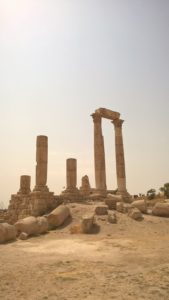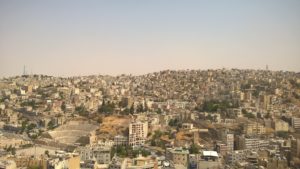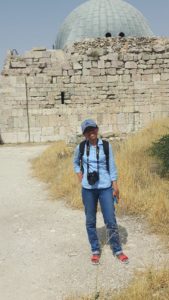
The intense schedule at Qasid leaves students with little time for leisure, but one of the first things I did in Jordan was make some time to see the Roman Citadel that dominates the center of the city. It was an extremely hot and sunny day when we made the trip, and I could not help but wish that we had brought an umbrella to shield ourselves from the sun. In retrospect, I probably should have used more sunscreen.
Whatever the case, the Amman Citadel (or Jabal al-Qala’a, lit. The Mountain of the Citadel) was clearly chosen by so many ancients for its location, for it is situated on a high hill from which one can see Amman in its entirety. Our tour guide pointed out various parts of the city from our vantage point, from the long strips of green trees of the King’s palace to the dusty marketplaces of the heart of the city. Everything is laid before the Citadel, and we spent a lot of time simply admiring the vista.
But the ruins atop the hill are the main reason I went up. A crossroads of civilization, the citadel has Roman and Byzantine roots, with the remains of Hellenic temples interspersed with early Christian churches and Umayyad masjids.
The giants of both Western and Eastern civilizations have passed through here, and I found it interesting how this hilltop, which was a symbol of dominance for centuries upon centuries, is now hardly being used at all and apparently of little interest to the Jordanians themselves. For there were only a few small groups of tourists on the grounds of the citadel and most of the Jordanians we saw there, save for a hijabi art student who was sketching the pillars, were only there to serve as tour guides. While the ancients, be they Roman or Arab, may have been using this spot to lord it over the common folk, but now the descendants of those same common folk could now care less for their citadel.
But while the indifference Jordanians have towards their Citadel can be considered amusing, it is unfortunate to see that that indifference also translates into neglect. Everywhere we looked, be it the pits used by the ancients to form cement or the hands of Hercules, there would be discarded water bottles or cigarette boxes simply left lying there.
Indeed, it often felt like very little effort was being undertaken to preserve the location. Our tour guide told us that twelve guards were meant to be stationed at the Citadel on a round the clock basis in order to protect the gathered historical relics. As we walked around the Citadel, however, no such guards were anywhere to be found. While we were walking in the old Church ruins, we watched as a group of tourists were casually climbing up on top of the old Church walls in order to take a few selfies. No one seemed to care as they desecrated these ancient ruins (while also, incidentally, put themselves at great risk of breaking their necks) all in the name of having another photo to upload to Facebook.
An argument could be made that not every country has the resources to preserve its historical sites, but Jordan is most certainly not a country without resources. The opulent, western-style malls filled with the very latest Hollywood blockbusters, designer clothing and lavish body care products are evidence enough of Jordan’s wealth. So why is it then that the Citadel is left to its own devices?
Perhaps part of the reason why this occurs is the obsession Jordanians seem to have with becoming Western. Throughout the roads of Amman, I’ve seen so many Jordanians driving ‘high status’ cars, be it the BMW, the Mercedes or the Priuses. There is a very real drive here to indulge in all of the petty opulence that ‘the West’ has to offer, and as a result it often feels as though the Jordanian identity itself is being eroded.
Sadly, it is not enough to be connected with the storied past of three magnificent civilizations that laid roots here in Jordan. For many Jordanians, pride seems to stem more from what one can possess now, be it the cars they drive or the clothes they wear.
Perhaps attitudes will change in time, but for now I left the Citadel wondering just what those Roman Patricians, Byzantine Emperors or Umayyad Caliphs would think knowing that one day their awe-inspiring citadels would simply be a passing curiosity to a city that is far more interested in emulating someone else entirely.

